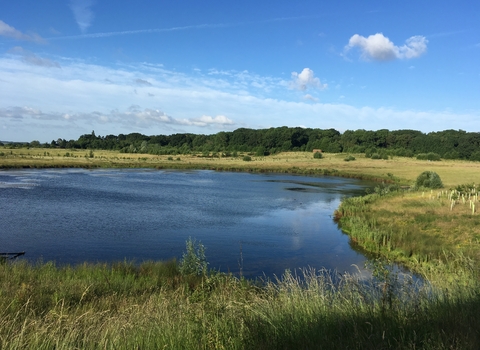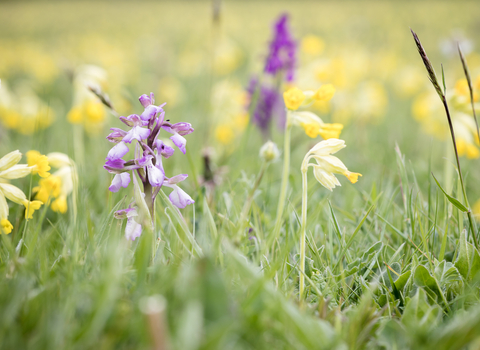Discover new places and embrace nature
Our wildlife reserves are wonderful places to observe nature and experience different habitats. From swooping barn owls to vibrant fields of orchids, there are endless wild delights to discover in Warwickshire, Coventry and Solihull.
Find an accessible nature reserve
Limited mobility shouldn’t mean missing out on nature. We are working hard to make our reserves more accessible for everyone.

Bubbenhall Meadow pool by Debbie Wright
Bubbenhall Wood & Meadow
This ancient woodland has been present since at least 1600. The Trust acquired the site in 2016 and has worked hard to enhance the existing woodland and meadow habitats through traditional management practices.
Look for hazel, elder, holly and ivy, flowers such as wood anemone, honeysuckle and wood avens. Spring sees floods of bluebells before the canopy closes over for the summer. Over winter, woodpeckers excavate nests in which to raise their young. In summer, the woodland is full of small birds including tits, finches and warblers (which also draw predatory sparrowhawks) with sunny areas attracting many butterflies, including white letter, purple hairstreak, silver-washed fritillary and the vivid yellow brimstone.

©Andy Rouse/2020VISION
Whitacre Heath
Whitacre Heath is a great place to explore different habitats, from open water through to marsh and the wet woodland, which supports a variety of wildlife. Rare grazing meadows, on the floodplain of the River Tame, have been maintained as open pasture here for the last few decades.
Look for water birds like little grebe, tufted duck, water rail and teal. Waders such as lapwing, redshank and snipe are also regular visitors to the large areas of wet grassland. In summer you will also see dragonflies and butterflies. Willow tits often visit and can be heard calling in the spring. Barn owls hunt the rough grassland and might be seen early in the morning or at dusk, especially during the breeding season of March to August.
Clowes Wood credit Anna Squires
Clowes Wood & New Fallings Coppice
Our very first nature reserve, this woodland has been owned by the Trust for almost 50 years and has been sensitively managed for its woodland, heathland and wetlands. A beautiful place to visit in spring when you can enjoy carpets of bluebells and wild garlic, and hear the song of migrant warblers announcing their arrival back in the UK.
Look for woodpeckers, tawny owls, tits and finches, wild flowers, and a variety of autumn fungi. In winter, foraging flocks of small birds might include long tailed tits, tree creepers and even lesser spotted woodpeckers. Woodcock are night-feeders on the woodland floor, often emerging from their roosts at dusk. Wildflowers that thrive here include bilberry, lily of the valley, bluebell and cow-wheat. Many mammals live in the woodland; the diminutive muntjac and stealthy red fox are both regular visitors.

Draycote Meadows
These picturesque hay meadows show hints of their ancient origins; try to spot the ridge and furrow markings as you discover the orchids, stream and abundant wildlife. Wildflowers carpet the meadow in spring and early summer. While butterflies find flower nectar, caterpillars feed on the plants themselves. In winter, thrushes such as redwing feed on berries from the hedgerows. Both meadows are renowned for spectacular displays of green-winged orchid, an indication of the site's antiquity. Autumn spawns an amazing range of fungi, with a dozen species of waxcap alone. Other distinctive fungi include white and smokey spindles and meadow coral.
Six-spot burnet, Hampton Woods, meadow by Andy Brough
Hampton Wood & Meadow
Hampton Wood & Meadow is a wonderful example of ancient woodland and damp riverside grassland where our volunteers carefully manage the trees to allow light onto the woodland floor encouraging flora, fauna, and new tree growth. Over 500 species of beetle have been recorded here! Boasting a beautiful carpet of wild flowers in spring, this reserve is famed for its primroses, bluebells, wood anemone and lesser celandine. Red campion and foxglove flower alongside ground-ivy and yellow archangel. In the spring, toads breed in the wetlands whilst sparkling blue kingfishers are regularly seen as they dart into the River Avon.

